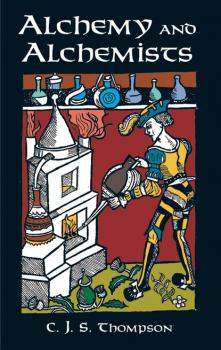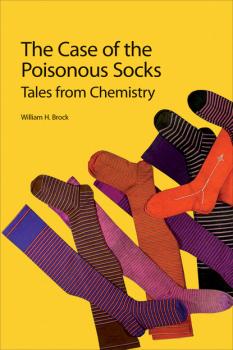ТОП просматриваемых книг сайта:
Химия
Различные книги в жанре Химия, доступные для чтения и скачиванияАннотация
"Chemistry, in particular, is capable, when suitably presented, of making a strong appeal to the intelligence and the imagination; for, as the following pages are intended to show, it is the most romantic of all the branches of science; and in its variegated history, stretching back through unnumbered generations of alchemists into an indefinite past, its present votaries have (if they but knew) a richly human and humanistic heritage." — from the PrefaceWritten for the layman, this accessible history takes a broad, humanistic perspective, eschewing chemical equations and formulae. Instead it concentrates on the great figures of chemistry and the ideas that revolutionized the science, from earliest history to the modern era.Much of the book is devoted to alchemy and such topics as the philosopher's stone, alchemical crypticism and symbolism, pseudo-alchemists, Paracelsus, and the «swan song» of alchemy as the scientific revolution took hold. In the final chapters, the author takes up the development of modern chemistry, including atomic theory, the nature of the elements, the beginning of organic chemistry, and more. Broad in scope, erudite yet readable, this rich and absorbing narrative will appeal to anyone interested in the long and colorful history of chemical science. Glossary. 50 illustrations.
Аннотация
One of the greatest experimental scientists of all time, Michael Faraday (1791–1867) developed the first electric motor, electric generator, and dynamo — essentially creating the science of electrochemistry. This book, the result of six lectures he delivered to young students at London’s Royal Institution, concerns another form of energy — candlelight.Faraday titled the lectures «The Chemical History of a Candle,» choosing the subject because, as he explained, «There is not a law under which any part of this universe is governed which does not come into play and is not touched upon [during the time a candle burns].»That statement is the foundation for a book that describes, with great clarity, the components, function and weight of the atmosphere; the function of a candle wick; capillary attraction; the carbon content in oxygen and living bodies; the production of carbon dioxide from coal gas and sugar; the properties of carbonic acid; respiration and its analogy to the burning of a candle; and much more. There is also a chapter comprising Faraday's «Lecture on Platinum.»A useful classroom teaching tool, this classic text will also appeal to a wide audience interested in scientific inquiry.
Аннотация
Written in 1661 by the founder of Boyle's Law, a major figure in the scientific revolution of the 17th century, this chemistry classic departs from alchemical tradition by asserting that all natural phenomena can be explained by the motion and organization of primary particles. Contents: Introduction. Physiological Considerations Touching the Experiments Wont to Be Employed to Evince Either the Four Peripatetick Elements, or the Three Chymical Principles of Mixt Bodies. Six Parts. Conclusion.
Аннотация
Clear and readable, this fine text assists students in achieving a grasp of the techniques and limitations of statistical mechanics. The treatment follows a logical progression from elementary to advanced theories, with careful attention to detail and mathematical development, and is sufficiently rigorous for introductory or intermediate graduate courses.Beginning with a study of the statistical mechanics of ideal gases and other systems of non-interacting particles, the text develops the theory in detail and applies it to the study of chemical equilibrium and the calculation of the thermodynamic properties of gases from molecular structure data. The second half offers a lucid, logical presentation of the canonical ensemble and of the grand ensemble, which constitute the theoretical bases for modern advanced equilibrium statistical mechanics. Other topics include the applications of both advanced and elementary theory to a number of interesting problems in physical chemistry — radiation phenomena, the solid state, fluctuations and noise problems, the statistical mechanical aspects of light scattering theory, paramagnetism and magnetic cooling, dielectrics, the theory of electrolyte solutions, nonideal gases, distribution functions for dense fluids, and the Ising model for the study of order-disorder transitions in biological macromolecules. Numerous problems enhance the book's value as a classroom text.
Аннотация
Alchemy, whose beginnings — possibly in Egypt, Babylon, India, or China — are ancient and obscure, remained undocumented until about 2500 BC. Although it may have originated with metallurgy, the practice rapidly developed an association with magic, pharmacy, and astrology. In this richly illustrated and amply researched study, a noted expert traces the long history of alchemy, from its murky start to modern times. Hermes Trismegistus and other famous alchemists appear here, along with discussions of the craft's associations with chicanery (as memorably portrayed in Ben Jonson's 1610 comedy, The Alchemist), and its role in the secret society of Rosicrucians. Additional topics include the alchemist's laboratory and equipment, alchemical symbols and secret alphabets, noteworthy manuscripts, the influence of astrology, and more. Although regarded today as a pseudoscience, alchemy gave rise to scientific chemistry. This volume illustrates the ways in which efforts to transmute metals — such as the search for the ever-elusive philosopher's stone — stimulated experimentation with hitherto untried substances, leading to improved knowledge of the materials vital to applied chemistry. Anyone intrigued by the origins and practices of this age-old and still-mysterious discipline, as well as those interested in the history of chemistry, will appreciate this concise, authoritative study.
Аннотация
Christian is one of the world's most well-known conceptual poets. Crystallography brought a scientific rigour and sensibility to poetry, while Eunoia was an Oulipian exercise in severe constraint and a radical experiment in language. Eunoia won the 2002 Griffin Poetry Prize and has sold 35,000 copies in North America. The Xenotext is a kind of experiment – a literary exercise that explores the aesthetic potential of genetics in the modern milieu. Christian Bök is in the process of composing a beautiful, anomalous poem, whose “alien words” might subsist, like a harmless parasite, inside the cell of another life-form.This is the first volume, of two, about The Xenotext. It will include Christian’s writings about and around the experiment; there is a long poem about the hellish origins of life on Earth, a series of writings and texts that will introduce the reader to the basics of genetics, amino acids and helices, complete with numerous illustrations. It sets the groundwork for the second volume, which will document the experiment itself.The experiment has been going on for more than ten years, and has already received media attention from BBC, Harper's, The Guardian, Maclean's, as well as from the scientific and literary communities.
Аннотация
Hand cream, detergent, shower gel, toothpaste, toilet cleaner, air freshener, lipstick, perfume, low-fat spread, painkiller, diet drink, insect repellent… hundreds of everyday products that make our lives so much better than those of our forebears. And yet most of us know little about the ingredients they contain and why they deliver the benefits we enjoy. Some people find it worrying when they examine the list of ingredients on a packaging label, because all they read may be unintelligible names or E numbers. It appears to be just chemicals, chemicals, chemicals. The aim of this book is to examine the ingredients more closely and explain the reasons for their being used.Start reading and stop worrying.Chemistry at Home has been written by award-winning popular science writer and chemist, John Emsley, using non-technical language. The book has 12 chapters, each devoted to the kinds of products we are likely to find around the home, including in the garage and the garden shed. Chemistry at Home also includes a glossary which gives more technical information about the molecules mentioned in the book.
Аннотация
Computer-Assisted Structure Elucidation (CASE) systems are a combination of software algorithms and tools to support and enable chemists and spectroscopists engaged in the process of molecular structure elucidation via the analysis of spectroscopic data. These expert systems dramatically reduce the time associated with structure elucidation and improve the reliability of the results. Contemporary Computer-Assisted Approaches to Molecular Structure Elucidation describes the principles on which these expert systems for spectroscopic structure elucidation are based and concisely explains the algorithmic concepts behind the programs. The authors use their own personal experiences in the development of the Structure Elucidator (StrucEluc) CASE software system to discuss the present state-of-the-art in computer-assisted structure elucidation. Scientists that are presently using CASE systems will be interested in the algorithms and modern approaches and for organizations that are currently using the StrucEluc platform the book is designed to help researchers understand the strategies behind CASE as well as details regarding the StrucEluc platform. For scientists that have never used CASE systems they will now have access to all necessary information to understand CASE systems for mastering this new and very effective approach to structure elucidation. The authors overall goal is writing this book is to produce the 'must read' definitive text that will represent the results of decades of work to develop computer-assisted structure elucidation software systems. CASE systems are now powerful software tools commonly outperforming and correcting human interpretations of data. This book will also provide an historical perspective of the work of the founding fathers of the technique and identify the challenges that have been overcome to produce modern CASE systems.
Аннотация
"For centuries fireworks have been a source of delight and amazement in cultures around the world. But what produces their dazzling array of effects? This book takes you behind the scenes to explore the chemistry and physics behind the art of pyrotechnics. Topics covered include history and characteristics of gunpowder; principles behind each of the most popular firework types: rockets, shells, fountains, sparklers, bangers, roman candles and wheels; special effects, including sound effects, coloured smokes and electrical firing; firework safety for private use and displays; and firework legislation. The Chemistry of Fireworks is aimed at students with A level qualifications or equivalent. The style is concise and easy to understand, and the theory of fireworks is discussed in terms of well-known scientific concepts wherever possible. It will also be a useful source of reference for anyone studying pyrotechnics as applied to fireworks. Review Extracts «„a worthwhile addition to the pyrotechnist's library“» Fireworks «„a useful source of information which makes absorbing reading.“» Angewandte Chemie, International Edition"
Аннотация
In 1868, The Times reported that poisons contained in dyes were affecting the public's health. A doctor informed a London magistrate that brilliantly coloured socks had caused severe «constitutional and local complaint» to several of his patients. In one case, a patient's foot had become so swollen that his boots had to be cut off. Respected chemist, William Crookes, offered to identify the poison if doctors would send him samples of the deadly socks. The story of how he solved the mystery gives this book its title and forms the basis of the first chapter. Written by a respected science historian and established author, this collection of essays contains 42 tales of chemists and their discoveries from the nineteenth and twentieth centuries. Other topics covered include: the quirky beliefs of American philanthropist, George Hodgkins; the development of the chemical laboratory since the 1830s, and the career of C.P. Snow before he became a novelist. Its broad coverage and modern approach makes it of interest to chemists, teachers, historians and laypeople with an interest in science. Written with a light style and presented in a series of unconnected vignettes the book is easy to dip into at leisure.










